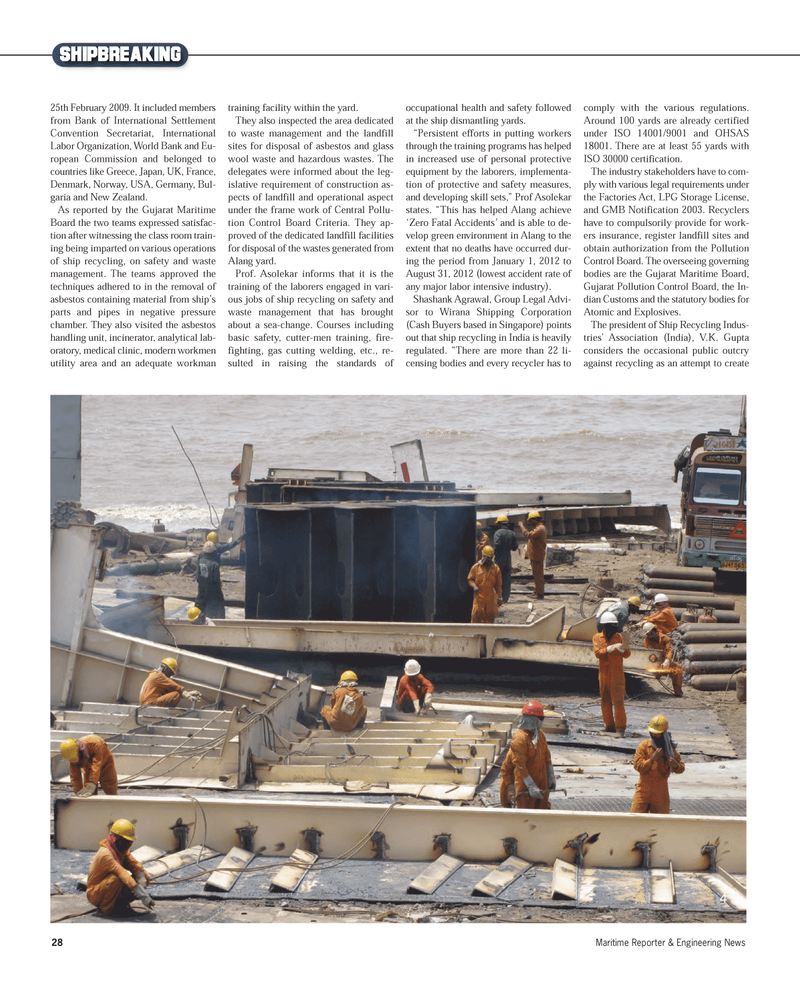
Page 28: of Maritime Reporter Magazine (December 2012)
Great Ships of 2012
Read this page in Pdf, Flash or Html5 edition of December 2012 Maritime Reporter Magazine
28Maritime Reporter & Engineering News 25th February 2009. It included membersfrom Bank of International SettlementConvention Secretariat, International Labor Organization, World Bank and Eu- ropean Commission and belonged tocountries like Greece, Japan, UK, France, Denmark, Norway, USA, Germany, Bul- garia and New Zealand. As reported by the Gujarat MaritimeBoard the two teams expressed satisfac- tion after witnessing the class room train-ing being imparted on various operations of ship recycling, on safety and waste management. The teams approved the techniques adhered to in the removal of asbestos containing material from ship?s parts and pipes in negative pressure chamber. They also visited the asbestos handling unit, incinerator, analytical lab- oratory, medical clinic, modern workmen utility area and an adequate workman training facility within the yard. They also inspected the area dedicated to waste management and the landfill sites for disposal of asbestos and glasswool waste and hazardous wastes. The delegates were informed about the leg- islative requirement of construction as- pects of landfill and operational aspect under the frame work of Central Pollu- tion Control Board Criteria. They ap- proved of the dedicated landfill facilities for disposal of the wastes generated from Alang yard. Prof. Asolekar informs that it is the training of the laborers engaged in vari- ous jobs of ship recycling on safety and waste management that has brought about a sea-change. Courses includingbasic safety, cutter-men training, fire- fighting, gas cutting welding, etc., re- sulted in raising the standards ofoccupational health and safety followed at the ship dismantling yards.?Persistent efforts in putting workers through the training programs has helpedin increased use of personal protective equipment by the laborers, implementa-tion of protective and safety measures, and developing skill sets,? Prof Asolekar states. ?This has helped Alang achieve ?Zero Fatal Accidents? and is able to de- velop green environment in Alang to the extent that no deaths have occurred dur- ing the period from January 1, 2012 toAugust 31, 2012 (lowest accident rate of any major labor intensive industry). Shashank Agrawal, Group Legal Advi- sor to Wirana Shipping Corporation (Cash Buyers based in Singapore) points out that ship recycling in India is heavily regulated. ?There are more than 22 li- censing bodies and every recycler has to comply with the various regulations. Around 100 yards are already certified under ISO 14001/9001 and OHSAS18001. There are at least 55 yards with ISO 30000 certification. The industry stakeholders have to com- ply with various legal requirements under the Factories Act, LPG Storage License, and GMB Notification 2003. Recyclers have to compulsorily provide for work- ers insurance, register landfill sites and obtain authorization from the PollutionControl Board. The overseeing governing bodies are the Gujarat Maritime Board,Gujarat Pollution Control Board, the In-dian Customs and the statutory bodies forAtomic and Explosives. The president of Ship Recycling Indus- tries' Association (India), V.K. Gupta considers the occasional public outcryagainst recycling as an attempt to create ShipbreakingMR#12 (26-33):MR Template 12/3/2012 2:25 PM Page 28

 27
27

 29
29
